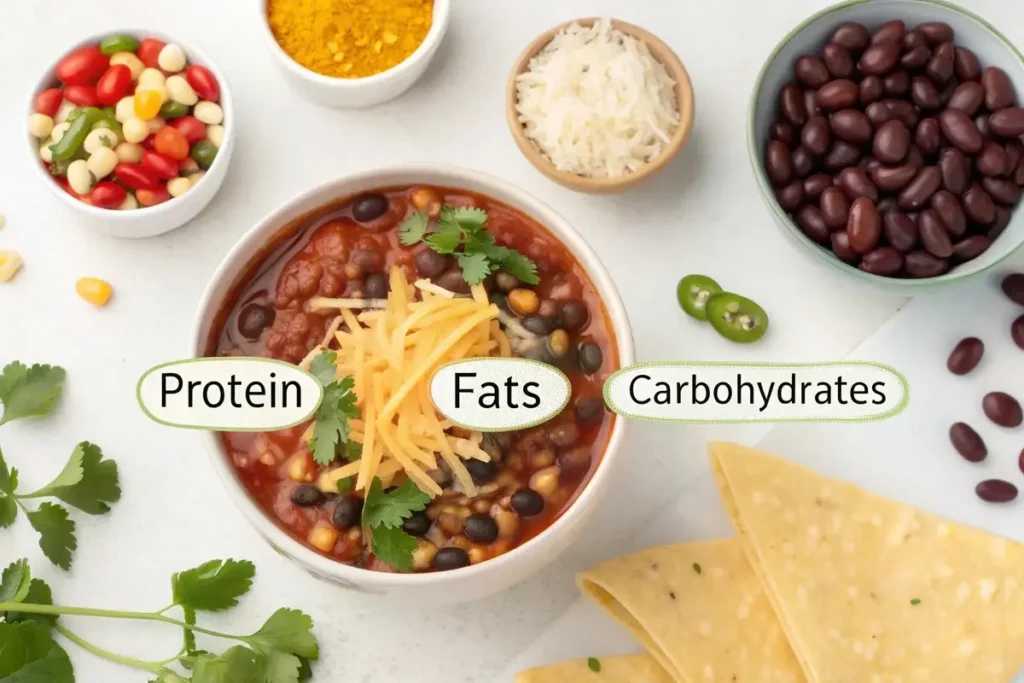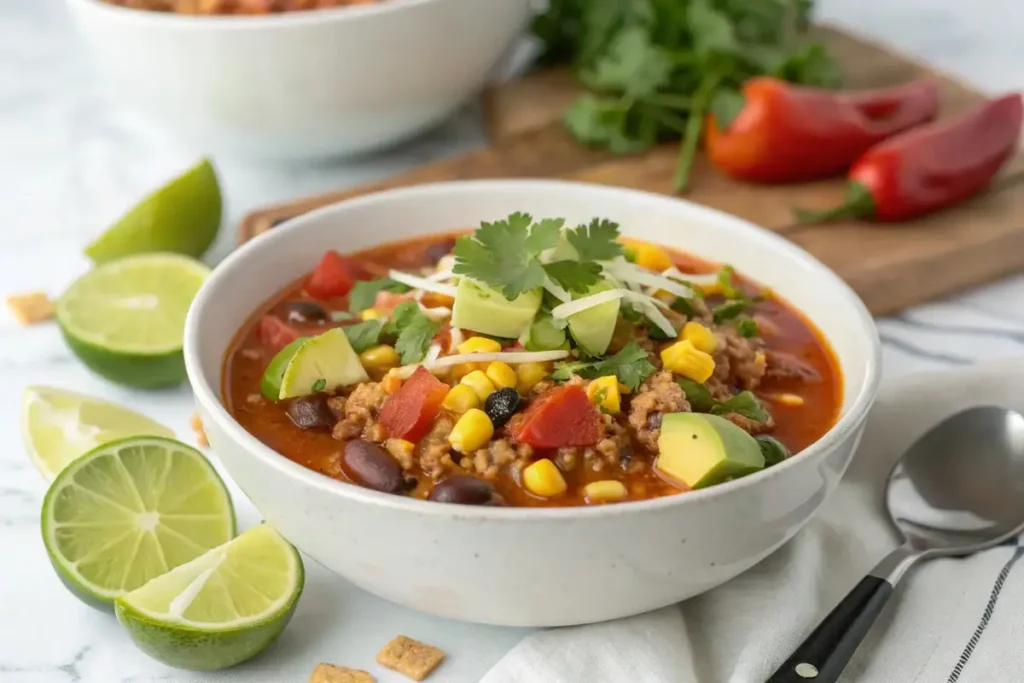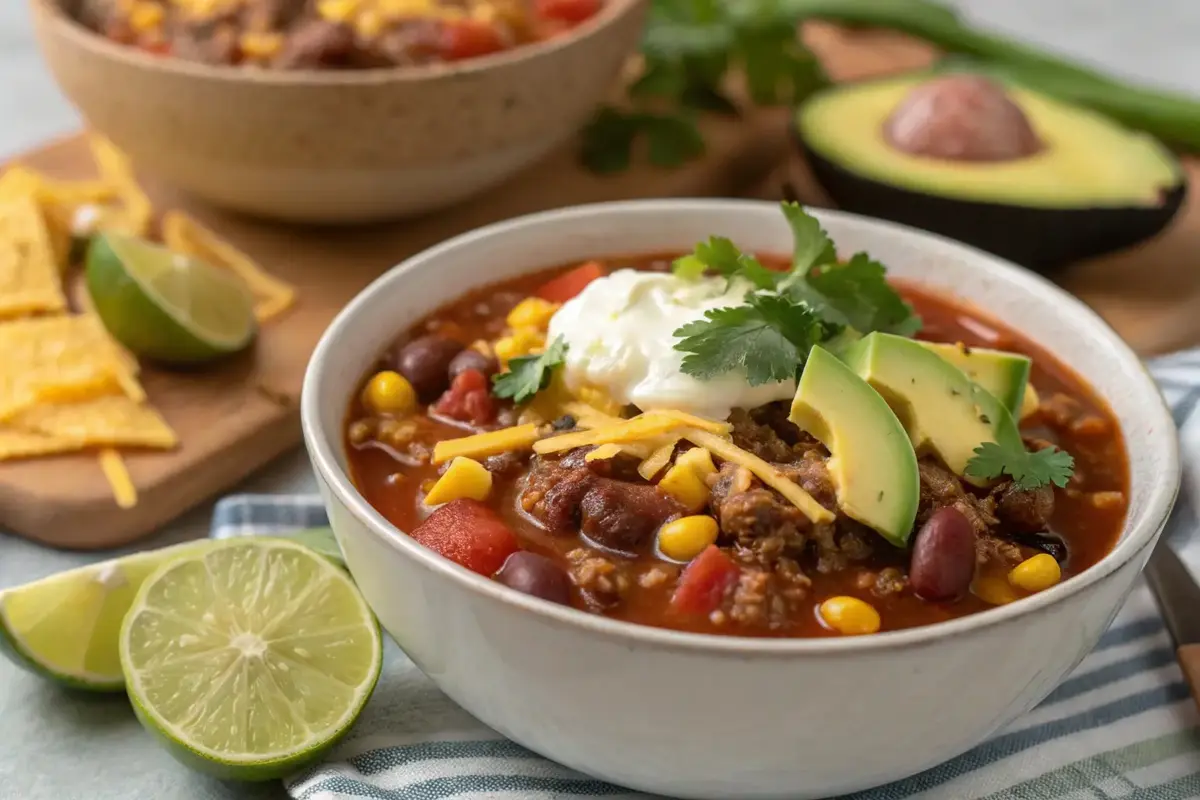Introduction
Taco soup is a fan-favorite comfort food that combines bold Tex-Mex flavors with hearty ingredients like beans, ground beef, and corn. But have you ever wondered how many calories are in taco soup? Understanding its caloric content is essential for anyone keeping an eye on their diet or aiming to make healthier choices. In this article, we’ll break down the average calorie count of taco soup, explore how ingredients impact its nutritional value, and provide tips for customizing your recipe to fit your dietary needs.
Part 1: Understanding the Calories in Taco Soup
Average Calorie Content in Taco Soup
Standard Serving Size (1 Cup)
On average, a one-cup serving of taco soup contains between 200 and 300 calories. However, the exact number depends on the ingredients used. A traditional recipe with ground beef and cheese will be higher in calories than a vegetarian version loaded with vegetables and beans.
Variations Across Recipes and Brands
Not all taco soups are created equal. Store-bought options may have additional sodium or preservatives, while homemade recipes can vary significantly based on portion sizes and ingredients. For example, soups with heavy toppings like sour cream, cheese, and tortilla chips will naturally have more calories. It’s worth comparing recipes or checking labels for precise information.
Factors That Affect Calorie Count
Protein Choices (Ground Beef, Chicken, Turkey, or Vegetarian Options)
Protein is a major contributor to the calorie count in taco soup. Ground beef tends to have the highest calorie content, especially if it’s not lean. Using ground turkey or chicken can reduce calories while maintaining flavor. Vegetarian options, like black beans or lentils, are even lighter while adding fiber and nutrients.
Inclusion of Beans, Corn, and Vegetables
Beans and corn are staples in taco soup, providing carbohydrates and a modest calorie boost. Vegetables like tomatoes, bell peppers, and onions contribute minimal calories but pack in vitamins and antioxidants, making them a healthy addition.
Impact of Toppings (Cheese, Sour Cream, Tortilla Chips)
Toppings can dramatically increase the calorie count of taco soup. For instance, a tablespoon of shredded cheese adds around 50 calories, while a dollop of sour cream can add 60 or more. Crushed tortilla chips contribute crunch and flavor but can quickly raise the calorie content if not portioned carefully.
Use of Broth Types (Chicken, Vegetable, or Beef)
The type of broth used in taco soup also plays a role. Chicken or vegetable broths are typically lower in calories than beef broth. Opting for low-sodium varieties can further reduce the calorie and sodium content without sacrificing flavor.
Part 3: Detailed Nutritional Breakdown
Macronutrients in Taco Soup
Calorie Distribution (Fat, Protein, Carbohydrates)
Taco soup provides a balanced macronutrient profile, making it a satisfying meal. On average, the calorie distribution for a cup of taco soup is as follows:
- Fat: 8–12 grams, depending on protein choice and toppings. Ingredients like ground beef and cheese contribute to the fat content.
- Protein: 15–20 grams, derived primarily from ground meat, beans, or vegetarian alternatives.
- Carbohydrates: 20–30 grams, thanks to beans, corn, and tomatoes. These carbs are often a mix of simple and complex sources.
This balance makes taco soup an excellent option for those looking for a hearty, nutrient-dense meal.
Importance of Fiber and Complex Carbs from Beans and Corn
Beans and corn are not just flavorful additions—they’re nutritional powerhouses. Beans like black beans and pinto beans are high in fiber, which aids digestion and helps you feel full longer. Corn provides complex carbohydrates, supplying sustained energy without causing spikes in blood sugar. Together, these ingredients make taco soup a satisfying and healthy meal option.
Micronutrients in Taco Soup
Vitamins and Minerals (Vitamin C, Iron, Potassium)
Taco soup is rich in essential vitamins and minerals. Ingredients like tomatoes and bell peppers offer a high dose of Vitamin C, which supports immune health and skin vitality. Beans and beef add iron, an essential mineral for energy production and oxygen transport. Corn and tomatoes contribute potassium, which helps regulate blood pressure and supports heart health.

Sodium Levels and How to Reduce Them
While taco soup is flavorful, it can be high in sodium due to ingredients like broth, canned beans, and taco seasoning. To lower sodium levels:
- Opt for low-sodium broth and canned goods.
- Use homemade taco seasoning to control salt content.
- Add fresh herbs like cilantro or lime juice to enhance flavor without extra salt.
Balancing sodium ensures that taco soup remains a heart-healthy choice.
Part 4: How to Calculate Calories in Your Taco Soup Recipe
Using Online Tools and Apps for Calorie Calculation
Step-by-Step Guide to Calculating Recipe Nutrition
- List all ingredients in your recipe, including toppings and portion sizes.
- Use a reliable online tool like MyFitnessPal or Verywell Fit’s Recipe Analyzer to input each ingredient.
- Adjust serving sizes to reflect accurate portions.
- Review the breakdown of calories, macronutrients, and micronutrients for a complete nutritional profile.
Best Apps for Tracking Recipe Nutritional Information
Some of the most user-friendly apps for tracking taco soup nutrition include:
- MyFitnessPal: Offers a comprehensive database and barcode scanner for packaged ingredients.
- Cronometer: Provides detailed micronutrient tracking, perfect for health-conscious individuals.
- Verywell Fit Recipe Calculator: Simplifies calculations for home-cooked meals.
Adjusting Recipes to Fit Your Dietary Needs
Reducing Calories with Leaner Protein Options
Switching from ground beef to leaner proteins like ground turkey or chicken can significantly lower the calorie content. Vegetarian options, such as lentils or tofu, are even lighter while adding plenty of protein and fiber.

Lowering Fat Content with Alternative Toppings
Instead of full-fat sour cream and cheese, opt for low-fat or fat-free versions. Greek yogurt is an excellent substitute for sour cream, providing creaminess with added protein.
Making High-Fiber, Low-Calorie Swaps
Replace half the meat with extra beans or vegetables to boost fiber while reducing calories. Adding zucchini, spinach, or diced carrots increases volume without adding significant calories, making your taco soup even healthier.
Part 5: Calorie Comparisons Across Taco Soup Variations
Traditional Taco Soup vs. Vegetarian Taco Soup
How Meat Affects Calorie Content
Traditional taco soup often uses ground beef, which significantly contributes to its calorie content. Depending on the fat percentage, a single serving of ground beef can add 200–300 calories per cup of soup. Switching to leaner meats like ground turkey or chicken can reduce this by 50–100 calories per serving.
The Role of Plant-Based Ingredients
Vegetarian taco soup eliminates meat, relying on beans, lentils, and vegetables as primary ingredients. These plant-based additions are naturally lower in calories and higher in fiber, making vegetarian versions lighter and more filling. For example, a vegetarian taco soup may average 150–200 calories per serving compared to 200–300 calories in the traditional version.
Slow Cooker vs. Stovetop Taco Soup
Differences in Cooking Methods and Ingredient Usage
Cooking taco soup in a slow cooker often allows for a richer flavor profile as the ingredients have time to meld together over hours. However, this method can sometimes require more broth to prevent drying, which may slightly dilute the calorie density.
In contrast, stovetop cooking allows for quicker reduction of liquid, resulting in a thicker, more calorie-dense soup. Additionally, stovetop recipes may encourage fresh ingredient usage, while slow cooker recipes often accommodate canned or pre-prepped options, impacting calorie and sodium content.
Store-Bought Taco Soup vs. Homemade Taco Soup
Pre-Packaged vs. Fresh Ingredients
Store-bought taco soup tends to have a higher calorie count due to preservatives, added sugars, and oils. A single serving may range from 250–350 calories, depending on the brand. Homemade taco soup, on the other hand, allows for complete control over ingredients, making it easier to reduce calories by using fresh vegetables, lean proteins, and low-sodium broth.
Sodium and Preservative Considerations
Pre-packaged soups are often loaded with sodium and preservatives to extend shelf life. A store-bought taco soup can contain upwards of 800–1,000 mg of sodium per serving, which is nearly half the recommended daily intake. Homemade taco soup offers the flexibility to use low-sodium broth, fresh spices, and herbs, cutting the sodium content dramatically while maintaining flavor.
By understanding these variations, you can make informed choices based on your dietary goals, whether you prioritize lower calories, higher nutritional value, or convenience.
Part 6: Frequently Asked Questions (FAQs)
FAQs About Calories in Taco Soup
What is the average calorie count for taco soup?
The average calorie count for taco soup typically ranges from 200 to 300 calories per cup. This can vary depending on the ingredients used, such as the type of protein, the amount of beans and vegetables, and whether calorie-dense toppings like cheese or sour cream are included. Homemade taco soup tends to be more customizable, allowing you to adjust the calorie content to suit your preferences.
How can I make taco soup lower in calories?
To reduce the calorie content of taco soup, try these strategies:
- Use lean proteins like ground turkey or chicken instead of beef.
- Increase vegetable content with low-calorie options like zucchini, spinach, or mushrooms.
- Opt for low-sodium or homemade broth to avoid hidden calories.
- Skip high-calorie toppings like sour cream and opt for lighter options like Greek yogurt or fresh herbs.
Are there low-calorie toppings for taco soup?
Yes! Low-calorie toppings can enhance your taco soup without adding significant calories:
- Fresh herbs like cilantro or parsley add flavor with virtually no calories.
- Diced avocado in moderation provides healthy fats and a creamy texture.
- Lime wedges add a zesty kick without any calories.
- Low-fat shredded cheese or fat-free Greek yogurt can replace heavier options like sour cream and full-fat cheese.
Does slow cooking affect the calorie count of taco soup?
The cooking method itself doesn’t change the calorie count of taco soup, but it can influence ingredient usage. Slow cooking often requires more broth to prevent drying, which may slightly dilute the calorie density per serving. On the other hand, stovetop cooking might allow for faster reduction of liquid, creating a thicker, more calorie-concentrated soup. Ultimately, the ingredients you choose matter more than the cooking method.
How do different proteins impact the calories in taco soup?
Proteins play a significant role in determining the calorie content of taco soup:
- Ground beef (especially higher-fat varieties) adds more calories compared to leaner options.
- Ground turkey or chicken reduces calories by 50–100 per serving while maintaining protein content.
- Plant-based proteins like beans or lentils are lower in calories and add fiber, making them a great option for vegetarians or those looking to reduce meat consumption.
Is vegetarian taco soup healthier than traditional recipes?
Vegetarian taco soup is often considered healthier due to its lower calorie content and higher fiber levels. Without meat, vegetarian versions rely on beans, lentils, and vegetables, which are nutrient-dense but lower in calories and fat. Additionally, plant-based recipes are typically lower in saturated fat, making them heart-healthier options.
Part 7: Conclusion
Making Calorie-Conscious Choices for Taco Soup
Balancing Flavor and Nutrition
Taco soup is a versatile dish that can be tailored to fit any dietary goal. By understanding the calorie content of key ingredients and making mindful substitutions, you can enjoy a flavorful and satisfying meal without exceeding your calorie budget.
Encouragement to Customize Recipes
Don’t hesitate to experiment! Whether you’re trying vegetarian options, adding more vegetables, or exploring healthier toppings, taco soup can be as light or indulgent as you like. With a few simple tweaks, you can create a delicious, nutritious bowl that aligns with your preferences and nutritional needs.

